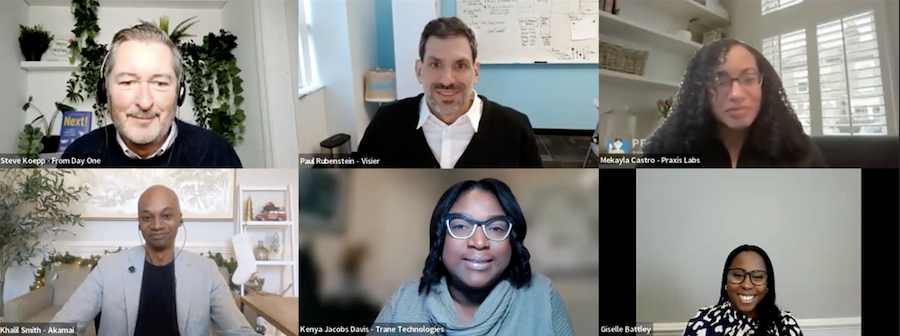Evolving Workforce Expectations: Key Areas for Leaders to Focus on in 2024


With the start of the new year, leaders are reflecting on a past year dominated by conversations about return-to-office and AI. Businesses also faced challenges like appealing to a new generation of workers and including diversity and inclusion practices, all while trying to meet their bottom line.
Where did they succeed? What could they improve on in 2024? These are the types of questions leaders discussed at From Day One’s December virtual conference, in a panel conversation moderated by Steve Koepp, From Day One’s chief content officer. The leaders shared what they learning in 2023 and what they’ve planned for 2024. Among the highlights:
Out With the Old, in With New Approaches
With a mixture of vague expectations and a lack of appealing reasons for returning to traditional office hours, the transition has been a challenge for leaders to tackle since the end of the pandemic. However, 90% of companies express a plan to create a formal return-to-office policy by the end of 2024, suggesting that RTO conversations will still be a dominant theme in the new year.
Leadership’s approach to this conversation needs to be different, said Khalil Smith, VP of inclusion, diversity, and engagement at Akamai Technologies. To get employees’ buy-in, leaders need to set their expectations clearly from the beginning and show the value proposition of well-spent office time.
“Ambiguity creates a lot of tension and a lot of frustration for folks. We need to think about things like how do we stay connected and continue to invest in our culture?” Smith said. “Every organization needs to choose the right path for themselves but they need to be incredibly articulate, unapologetic, and unambiguous about what they're doing and why.”
Setting clear expectations is only one part of the equation, said Paul Rubenstein, chief customer officer at software company Visier. Leaders need to model those behaviors for employees to follow as well to get their full support.
“There’s nothing worse than coming to the office to find no one else there. The value proposition of coming to that space has to be there and leaders have to be there,” Rubenstein said. “People follow leadership behaviors so if they see dissonance in what they say everyone should do and what leaders actually do, you’re done.”
Creating Better Pathways to Leadership
More women have moved into high-ranking executive jobs over the past few years. McKinsey’s 2023 Women in the Workplace report showed a positive growth of women in C-suite positions from 17% to 28% since 2015. But while overall women’s representation increased, women of color continue to be underrepresented in leadership roles.
This can be an alarming issue for Generation Z, who are set to be the most diverse workforce, said Giselle Battley, global head of early career talent at real-estate company JLL.
“If Gen Z is looking up and not seeing themselves in their immediate leadership, that’s an issue,” Battley said. “Leaders need to understand the landscape and know they are on the front lines driving the culture and the success, especially for those underrepresented members of your team.”
To support employees from underrepresented demographics, leaders, especially middle managers, need to provide their teams with the proper tools, Battley said.
“I can’t tell you how many times people get promoted and they’re never trained formally on DEI and they’re not given the tools to be effective,” Battley said. “Companies need to give them the tools to have that awareness to understand they are leading the charge to create this culture and change.”

From championing their employees to providing mentorship and support, leaders are instrumental in supporting employees’ development into leadership roles. Kenya Jacobs Davis, HR leader of manufacturing company Trane Technologies, explained how providing key opportunities to employees not only demonstrates trust but can be pivotal in their overall growth.
“One of the most powerful things that I’ve had happen over the last couple of years is not having someone speak for me, but sending me in their place,” Davis said. “Let’s not just talk about trust in terms of ‘I trust this person on my team, I know they’re capable,’ but demonstrating that trust by saying ‘You go instead of me.’ So when we talk about trust, it’s really important that you also model it when you have that opportunity.”
Building Up Employees for Success, Individually and Collectively
According to a Glassdoor poll, 76% of employees said they value a diverse workforce, and inclusive leadership leads the forefront of encouraging DEI in the workplace.
To do so, leaders need to nurture a strong one-on-one relationship with their employees to understand them, said Mekayla Castro, head of curriculum at immersive learning and development company Praxis Labs.
“To celebrate someone for their uniqueness, leaders need to have a strong one-to-one relationship with them.” Castro said. “Managers need to reflect on that dynamic they have with individuals and commit to understanding needs, motivations, expectations and goals that people have so they can then support them more equitably and inclusively,”
From there, leaders need to cultivate a sense of belonging with employees as well. Castro said engaging employees in team-building activities and exercises can help build interpersonal connectedness at a team level and increase overall employee engagement.
“Employees want to feel like they are part of a larger group,” Castro said. “Establishing a team identity or shared mental models can be helpful to build that high-quality connection at the team level.”
Wanly Chen is a writer and poet based in New York City.
The From Day One Newsletter is a monthly roundup of articles, features, and editorials on innovative ways for companies to forge stronger relationships with their employees, customers, and communities.